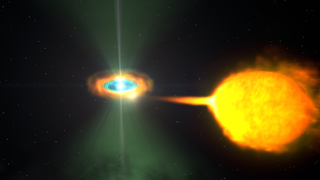Universe
ID: 10144
A pulsar is a rapidly rotating neutron star that emits pulses of radiation (such as X-rays and radio waves) at regular intervals. A millisecond pulsar is one with a rotational period between 1 and 10 milliseconds, or from 60,000 to 6,000 revolutions per minute. Pulsars form in supernova explosions, but even newborn pulsars don’t spin at millisecond speeds, and they gradually slow down with age. If, however, a pulsar is a member of a binary system with a normal star, gas transferred from the companion can spin up an old, slow pulsar to the millisecond range.
Millisecond Pulsar with Magnetic Field Structure
Related
Credits
Please give credit for this item to:
NASA
NASA
Short URL to share this page:
https://svs.gsfc.nasa.gov/10144
This item is part of this series:
Astrophysics Animations
Goddard TV Tape:
G2007-007HD
Keywords:
SVS >> HDTV
SVS >> Neutron Star
DLESE >> Space science
SVS >> Astrophysics
SVS >> Universe
SVS >> Pulsar
NASA Science >> Universe
https://svs.gsfc.nasa.gov/10144
This item is part of this series:
Astrophysics Animations
Goddard TV Tape:
G2007-007HD
Keywords:
SVS >> HDTV
SVS >> Neutron Star
DLESE >> Space science
SVS >> Astrophysics
SVS >> Universe
SVS >> Pulsar
NASA Science >> Universe












